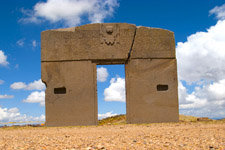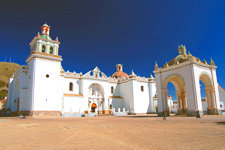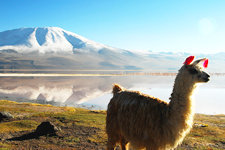Landlocked Bolivia lost its maritime coast to Chile after the War of the Pacific, although it maintains its official declaration of its right to access to the sea. It is bordered by Brazil, Paraguay and Argentine, Chile and Peru. In the west, massive Lake Titicaca, the world's highest navigable lake, and the Central Andean peaks dominate the landscape; the highest being Illimani and Sajama. Here high plains boasting many lakes and rivers and is enclosed by the Andean Range, Lake Titicaca, and the Uyuni Salt Flats, the largest in the world. The high Andean plains give way to the hot, semi-arid eastern lowlands of the Gran Chaco in the Amazon Basin. The high amount of altitudinal variation ranging from snowy Sajama 6,742 meters about sea level to 70 meters for the Paraguay River allows Bolivia to shelter a huge biodiversity in climates that spans from the altiplano high Andean plains to tropical rainforests, dry valleys to Los Llanos tropical savanna. Overall, there are 32 ecological regions with 199 ecosystems. Several reserves seek to protect this natural resource, including Madidi National Park and the Avaroa Andean Fauna National Reserve.
Bolivia is the least developed country in Latin America despite a wealth of natural resources that include the 2nd largest natural gas reserves in South America and 70% of the world's lithium reserves in the Uyuni Salt Flats; subsistence farming is still widespread throughout. Bolivia's main economic activities are agriculture, forestry, fishing, mining, refined metals and petroleum, and mineral exploitation, especially tin. It suffered from major decreases in financial aid from Western nations after the end of the Cold War in the late 1980s and early 1990s. Although rated "repressed" by the 2010 Index of Economic Freedom, the country is currently experiencing a higher rate of growth than in the preceding 30 years, a moderate decrease of inequality, and growing trade.
The Pre-Columbian Era
The region now known as Bolivia has been occupied for over two millennia; its earliest inhabitants were the Aymara, who would build Tiwanaku up from a small farming village around 1500BC to the center of the Kingdom of Tiwanaku starting around 600AD. As it grew into an urban power, pilgrimage site of cosmological prestige, and predatory state, it expanded through politics, trade and force throughout Bolivia and into Peru and Chile. Around 1000AD drought caused Tiwanaku to disappear, but scattered groups of Aymara, such as the Uros Tribe of Lake Titicaca's famous Floating Islands of Uros, survived to this day. The last great expansion of the Inca Empire conquered the region between 1438 and 1527, and thus Western Bolivia became part of the largest Pre-Columbian American state, the Inca Empire, for a brief period.
The Colonial Period
The Spanish Empire conquered the region the mid-16th century, ushering in a colonial period in which it was under the administration of the Viceroyalty of Peru and was known as Upper Peru.
It grew in prestige due to the founding of the silver mining town of Potosí in 1545, which soon became the New World's largest city thanks to the wealth extracted by indigenous forced labor. In 1776 Upper Peru was shifted to the Rio de la Plata Viceroyalty. Five years later the indigenous rebellion under Túpac Katari laid siege to La Paz, causing the deaths of 20,000 people but eventually failing.
Life as a Republic
Independence was declared in 1809, followed by 16 years of war before the Bolivian Republic was established in 1825. Wars with neighboring countries in the period following independence caused Bolivia to lose over half its territory, with the 1879-1883 War of the Pacific against Chile causing Bolivia to lose its access to the sea.
During the early 20th century Bolivia grew as it exploited its mineral wealth under a succession of governments headed by economic and social elites and advancing laissez-faire capitalist policies. In the 1950s the Revolutionary Nationalist Movement (MNR) rose to power and introduced universal suffrange and sweeping land reform. This turn to the left was followed by a military junta dictatorship, initiating decades of political turmoil between leftist revolutionaries and the CIA-backed Bolivia

Although Sucre is the constitutional capital of Bolivia, the city of La Paz (officially Nuestra Señora de La Paz) is the country's administrative capital. Located in Western Bolivia in a bowl...

Copacabana lies along the shore of the Bolivian side of Lake Titicaca; it's the country's principal access point for the lake as well as the first stop for many upon crossing the frontier from...

The Department of Potosí boasts two of Bolivia's most famous attractions, Uyuni Salar, the world's largest salt flat, and the Siloli Desert. Its capital is the city of Potosí, whose history of...

The small town of Rurrenabaque, often simply referred to by Bolivians as Rurre), is located on the banks of the Beni River in the Bolivian Amazon Basin, about 20 hours from La Paz by bus and 3...